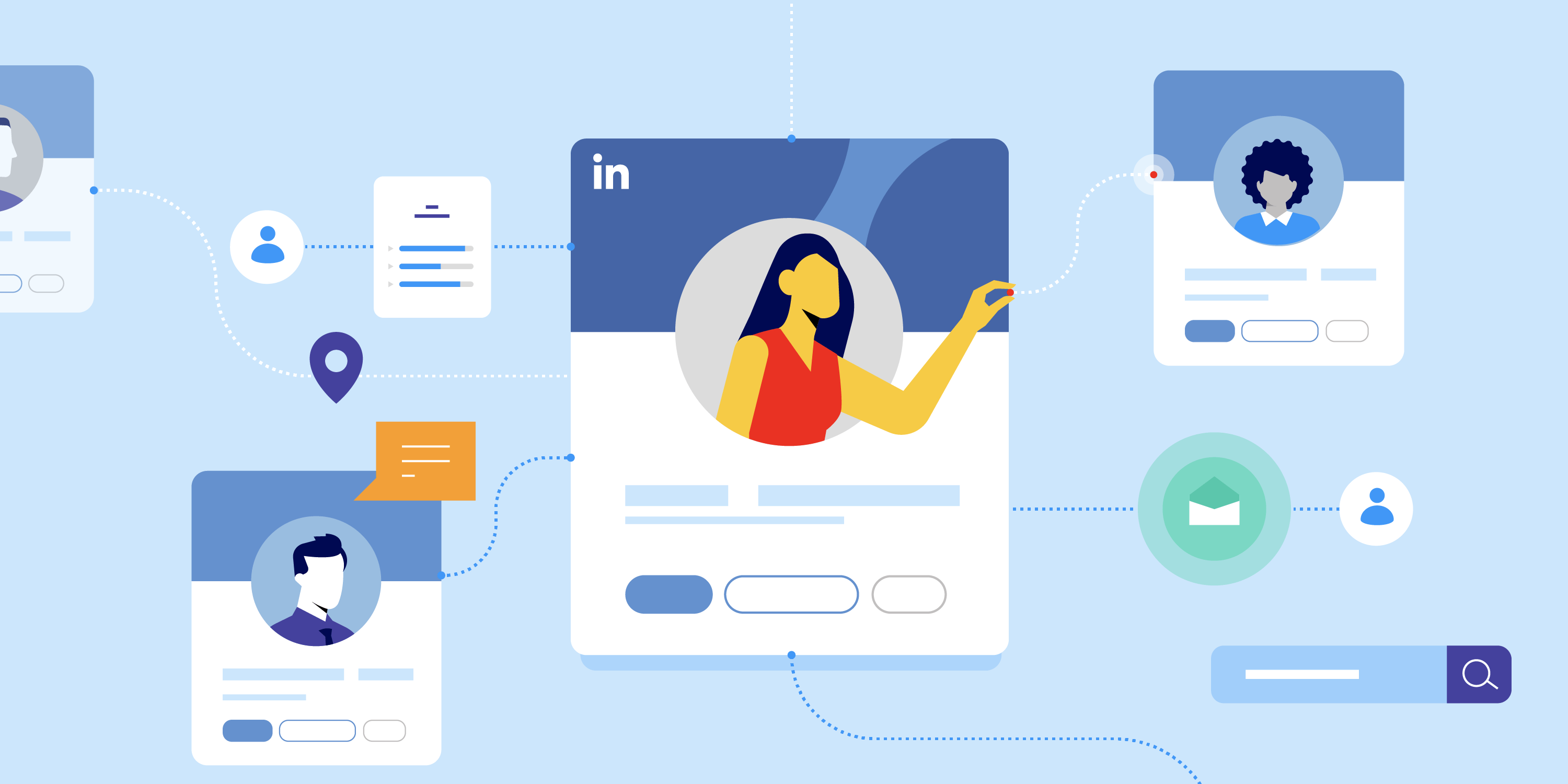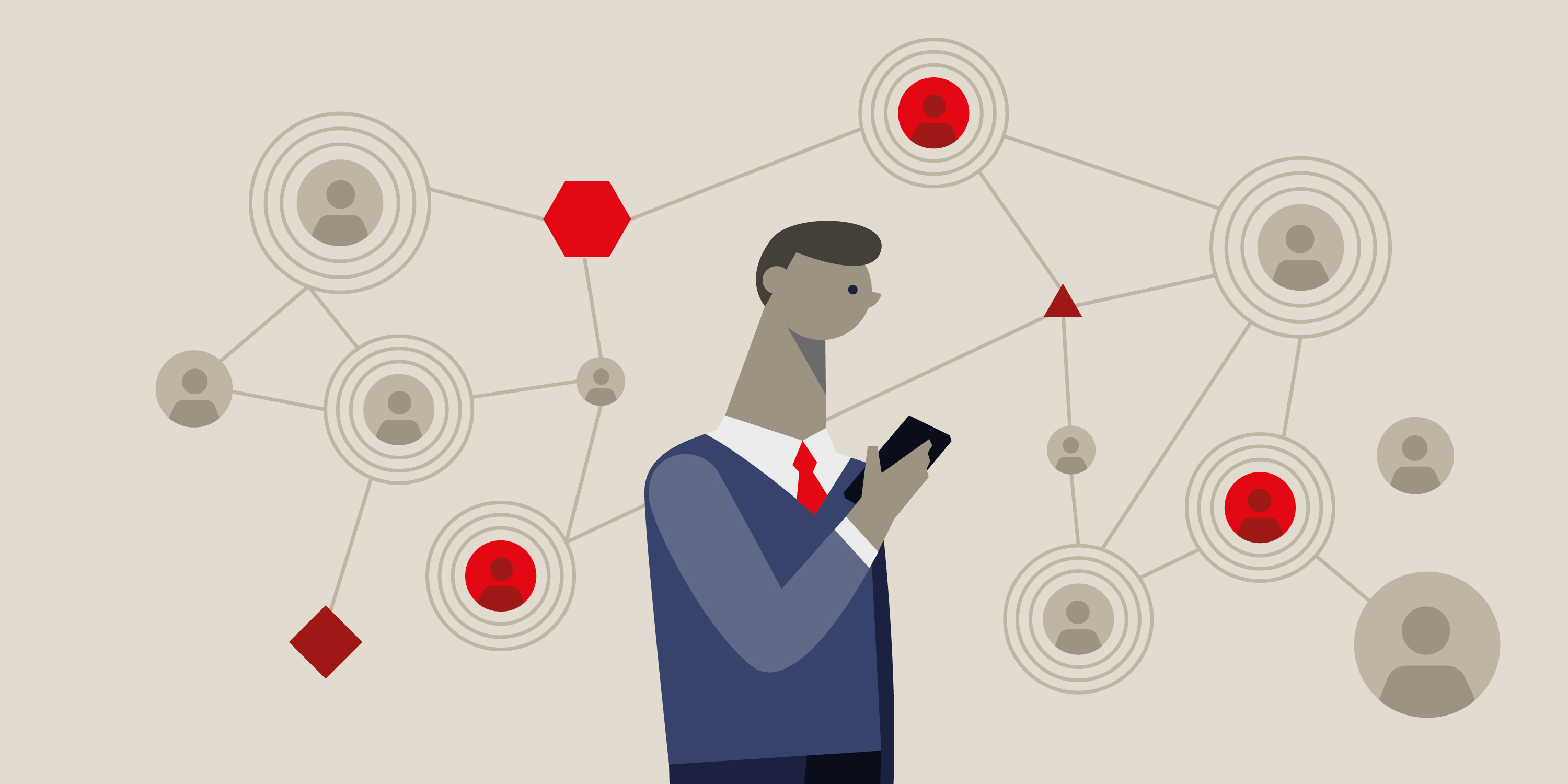Unlocking the Power of LinkedIn for Recruiters: Expert Strategies for Maximizing Success

Jordan Morten is an experienced recruiter and talent acquisition specialist who has held positions at the advertising tech startup MNTN and the global recruitment firm Aerotek. After more than 10 years in the industry, she launched her own recruiting services and career coaching firm, HireHearts Recruitment.
On the day her role was eliminated, recruiter Jordan Morten turned to LinkedIn to let people know that she was open to work. One post changed everything.
Thirty minutes after my role as a talent acquisition specialist at MNTN was eliminated during the height of tech layoffs in January 2023, I hit “Post.” I’d been a LinkedIn user for several years, but it was a passive platform for me. But on that day in early January, I decided to share a message about my situation. I needed support and guidance, and I knew there were other professionals out there who had experienced recruiter layoffs and would understand what I was going through at that moment.
I explained how I wanted to approach this unexpected challenge and made a call to action for everyone in my network. I asked them to like, share, and comment on the post and ping their own networks to share my skill set. I ended with a positive message that showed my eagerness to find the right career opportunity in the talent acquisition space.
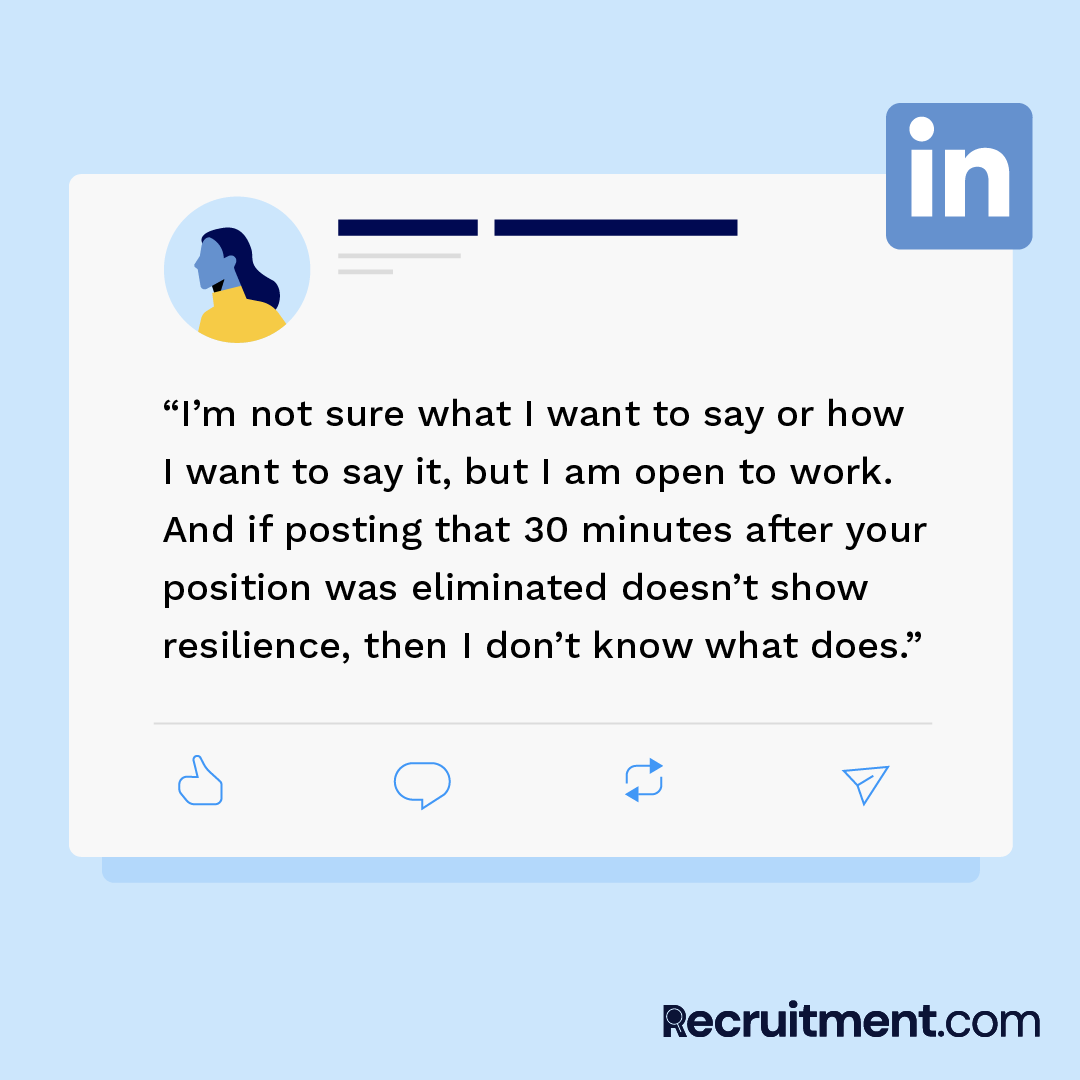
Part of Jordan’s real LinkedIn post on the day her position at a former employer was eliminated.
The post went viral. Within days, it received more than 167,000 reactions, 7,000 comments, and 10,600 reposts. I posted follow-ups on my profile and continued to see remarkable results. After only 30 days, the number of people following me on LinkedIn skyrocketed from 500 to more than 25,000, I increased my connections to 7,000 people, and my posts collectively garnered over 17 million impressions.
I had associated that kind of activity with social media sites like Instagram and TikTok, not thinking it was possible to achieve such a viral reaction on LinkedIn.
I quickly realized that the 930 million worldwide users of LinkedIn were an untapped market when it came to content creation—and that I could use the platform to grow my profile, not just look at candidate résumés. The post wasn’t just a momentary burst of popularity—it was a significant game-changer for my career. It led to many job interviews and offers. It also made me realize I had an opportunity to do even more in the recruitment space.
I leaned into content creation on the platform as I began building my own talent acquisition and career consulting brand, HireHearts Recruitment. Now I use unique content to grab the attention of both companies that need a recruiter and job seekers who are looking for the right opportunities. If they find my posts interesting and take the time to respond, then I know I can start conversations and quickly build my network from both ends.
LinkedIn can be one of your most powerful networking tools as a recruiter, but it’s also a challenge to successfully leverage the platform. Here’s what you need to know to boost your recruiter profile, turn connections into opportunities, and create the foundation for future success.
Getting Started
Prior to my viral post, when I was first getting interested in LinkedIn, I was that person who thought, “I can’t post because my LinkedIn profile isn’t updated and the bullet points on my job descriptions are not where I want them to be.” But my advice for recruiters looking to grow their LinkedIn network is to post. Just go for it!
If you don’t start consistently posting, then you’ll never be able to grow your network because you’ll be too focused on the little things. This is called analysis paralysis. You’re so focused on how to appear perfect that you forget you need to reach out to people before they notice you at all.
Posting, reposting, commenting on other people’s posts, having conversations—those are all better first steps than focusing inward. Once you get good conversations going, then go back to your own profile, update your picture, and build it all out. To be honest, not a lot of people—unless they’re looking for something really specific—are coming to your profile, reading through everything, and making a networking decision based on that. Your profile doesn’t really tell your story—it’s better told in conversations.
This is why LinkedIn is such a great tool for recruiters—we’re used to talking! We know how to make instant connections with people because it’s part of the work we do. Translating that ability to LinkedIn and tying it to your personality is part of the fun.
Know Your Audience
When I was looking for a new role, I could have jumped on Instagram and shared the same post that I did on LinkedIn. I would have been patted on the back and given some general words of encouragement. But that wasn’t what I wanted.
I wanted to speak to like-minded professionals, those who could offer more than just superficial support and may have gone through the same experience as me. I saw LinkedIn as an opportunity to brainstorm and collaborate with people at a higher level.
The audience on LinkedIn is very broad: According to global LinkedIn data, there are more than 57 million businesses and 65 million business decision-makers on the platform, and 61 million people around the world searching for jobs each week.
When your job is to act as the liaison between top-tier candidates and prominent companies, these numbers cannot be ignored. Your participation on LinkedIn allows you to engage in conversations and attract the attention of both decision-makers and job seekers—and you need to be an active, standout participant. When you know who you are talking to, you can tailor content to resonate with people and boost your recruiting ambitions.
I make posts for both fellow recruiters and job seekers and don’t worry too much about whether or not the content is interesting for both my audiences. It all serves a greater purpose. Because it’s social media, there is an entertainment aspect. But when you post entertainment-driven posts—like quotes, videos, or memes—you still want it to have a level of professionalism to it. If I’m posting or reposting something broad, I tie it back to career-related or leadership topics, because in those situations, nearly everyone can relate.
Create Your Niche
My initial LinkedIn post struck a chord because I showed vulnerability. I’m a mother, I’ve lived through mental health issues like anxiety and postpartum depression, and I have a family to support. I can speak to all of those big topics through experience. My vulnerability allowed me to create a rapport with people who have been where I was in early January—and who might be there now. I am willing to share my struggles with others, and I recognize this as the niche I can bring to LinkedIn—but I’m careful not to make that my entire identity on the platform.
When considering how to use LinkedIn as a recruiter, you should also be wary of creating a niche that is overly limiting. For example, maybe you primarily recruit nurses and know everything there is to know about that process. That may be the driving force behind your content, but it is unlikely to capture the zeitgeist. You need to develop content with mass appeal that you can then look at through a recruitment lens, rather than limiting your appeal from the start.
For instance, I recently took a photo of my daughter in an outfit she picked out: sparkly turquoise top, leggings bedecked with hearts, and a pair of ladybug galoshes. She completed the look with a purple sequined purse. I attached it to a post that began, “Convincing candidates that their résumés don’t match the job they are applying to is just as hard as convincing my 3-year-old that her outfit doesn’t match.”
The post focused on résumé guidance and strategic career planning, but did so in a fun way—because every parent, teacher, babysitter, or grandparent can relate to a headstrong child with a flair for “fashion.” Your goal is to find a unique and compelling way to look at a common business concept and grab people’s attention so they will continue to engage with your content—and hopefully you—in the future.
Work the Algorithm
When you create content on LinkedIn, you have to rise to the top of people’s feeds so they have a higher chance of seeing your posts. That means working within LinkedIn’s algorithm. While there’s no secret sauce to beating the algorithm, understanding how it works can help.
The algorithm ranks your content based on how likely someone is to interact with it. If you put low-quality content out there, your audience is not going to feel compelled to comment or share. You must create content that is recognized as high quality by the algorithm: posts that are easy to read and encourage responses with a question. You should also use a positive, relatable tone in each post—even if the subject matter is serious, end it on a note of hope, add a photo of your pet, or maybe add a question to prompt your readers to share how they handled a difficult situation for inspiration.
As more people engage with your content and follow you, your posts will begin to move up in people’s feeds and your visibility will grow. You need that recognition to stand out among the 72% of recruiters who use LinkedIn on a regular basis.
Keep Your Content Consistent
It’s important to be consistent with your posts, both in terms of how often you post and how your posts look. I try to post once a day, Monday through Friday, and I try different times of day.
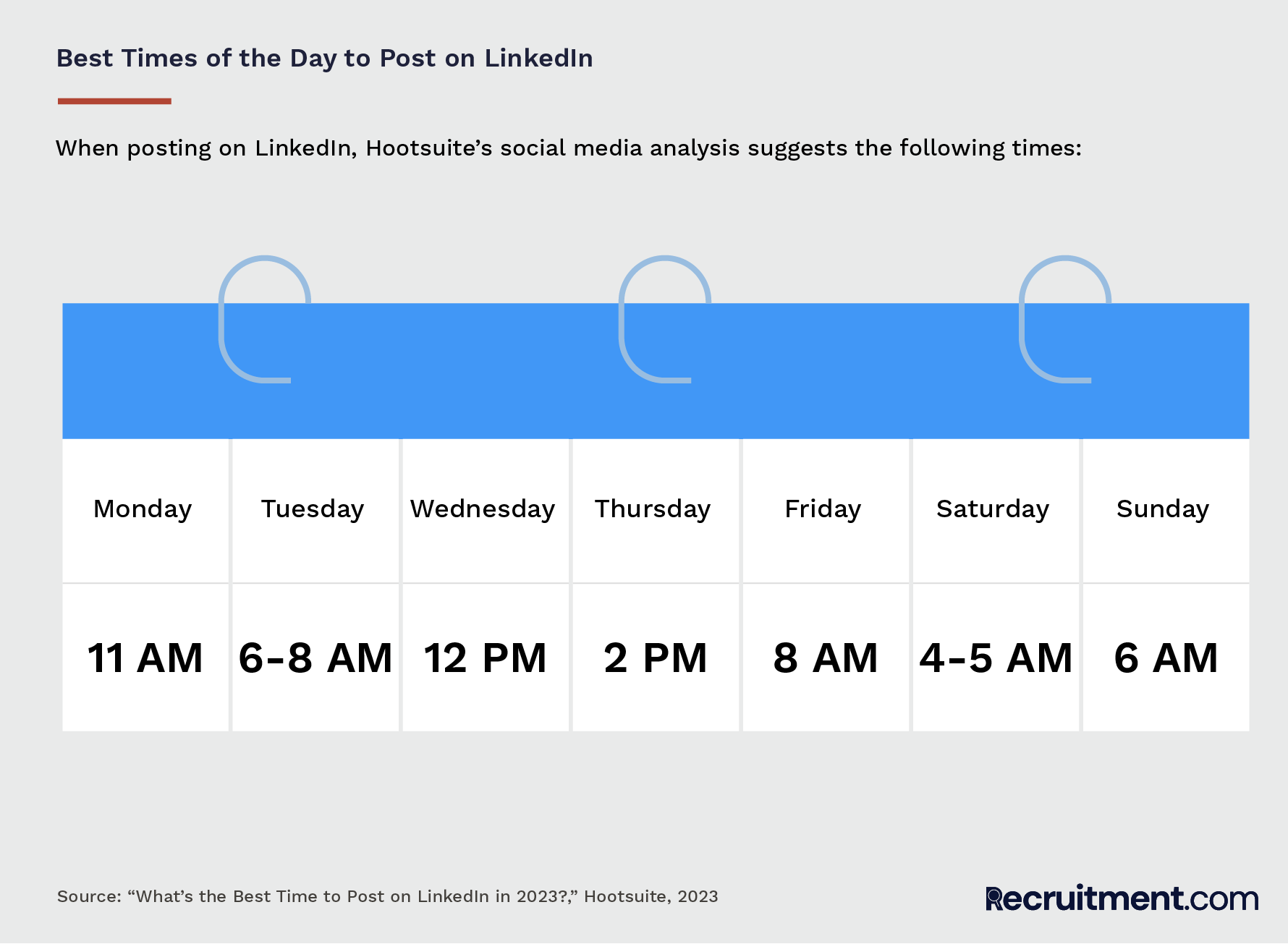
Although I don’t have a set post length, I always think about my busy audience and try to create content that is quick and easy to read. I start with an attention grabber—usually a sentence or two that encourages people to read on. Then I hit Return four to five times to create space between the opener and the rest of the content, which draws the reader in: If that first sentence catches them, they will click Read More, see the rest of the post, and be more likely to engage with the post in its entirety.
LinkedIn posts with graphics or images see twice as many comments compared to those without them. For shorter posts, I use an explanatory graphic, like infographics with compiled data; with longer posts, a picture is sufficient. I also typically include a question to promote interaction with short posts. Polls are also an efficient way to gather information for future content based on how people vote.
There are always going to be job seekers and companies looking for employees—as a recruiter, I have to be visible to those people and organizations. The more consistent I am with my posts, the better chance I have to reach the people who need my services, and the more opportunities I have to make important connections. If you are a consistent presence on LinkedIn then you will become known to those who need your services and your network will grow.
Turn Your LinkedIn Connections Into Relationships
LinkedIn gives you a professional space in which to share your insights and have authentic interactions. The key is to go beyond surface connections with your talent acquisition colleagues, job candidates, and business owners, and consider how to truly connect.
I am very deliberate in how I personally interact with people who comment on my posts. While I may not be able to respond to everyone, I try to engage with a majority of the comments. When I have a conversation with someone, I create a level of familiarity that encourages them to continue interacting with my posts and sharing them with others, thus boosting my profile across the platform and generating business leads. This garners more followers and, ultimately, more connections.
As your figures start to rise, it’s important to recognize the difference between your followers and your connections. All connections automatically become followers, but not all followers are connections. Followers are those people who intentionally hit the Follow button, rather than the Connect button, and keep up with your journey through your content. They receive notifications about your posts and they help to advance your profile. Over time, your followers may consider making a connection request. The more followers you have, the more valuable connections you stand to make.
I am currently in growth mode, so I choose to look at every connection as a good connection. But I am strategic about accepting connection requests. My connections are people who have helped me and whom I have been able to help in return. I look for a relevant connection that is mutually beneficial and can be maintained over the long term. Developing sustainable relationships is key as a recruiter, as you want companies and individuals to return to you every time they need talent acquisition or career counseling services. You need to become their go-to source for information and services. When you offer thought-provoking LinkedIn content regularly, you’ll remain on their radar and be the first person who comes to mind when they need a recruiter. And they’ll be able to reach out to you easily through LinkedIn.
You also need to be purposeful in your choice of connections because LinkedIn caps your number of first-degree connections at 30,000—but there’s no maximum on the number of followers you can have. You don’t want to fill your available connections with people you interact with only once—they need to be people you plan to connect with repeatedly.
While your follower and connection numbers may soar as you create compelling content, you have to remember to engage in business development activities. The growth of my LinkedIn profile was organic, unexpected, and amazing, but I still have to put in the work to build professional relationships on the back end. It’s all about making human connections online and offline—which is exactly what recruiters do every single day. Fortunately, people on LinkedIn want to network and help.
Network for the Future
When I began posting content on LinkedIn, I was looking for a way to pick myself up and move forward in my career. I wasn’t getting job offers or leads at first, but I stuck with posting because it felt good and was validating. I offered tips and advice about finding jobs and securing employees in a fun and engaging way, and it made people look at me as an expert in my field.
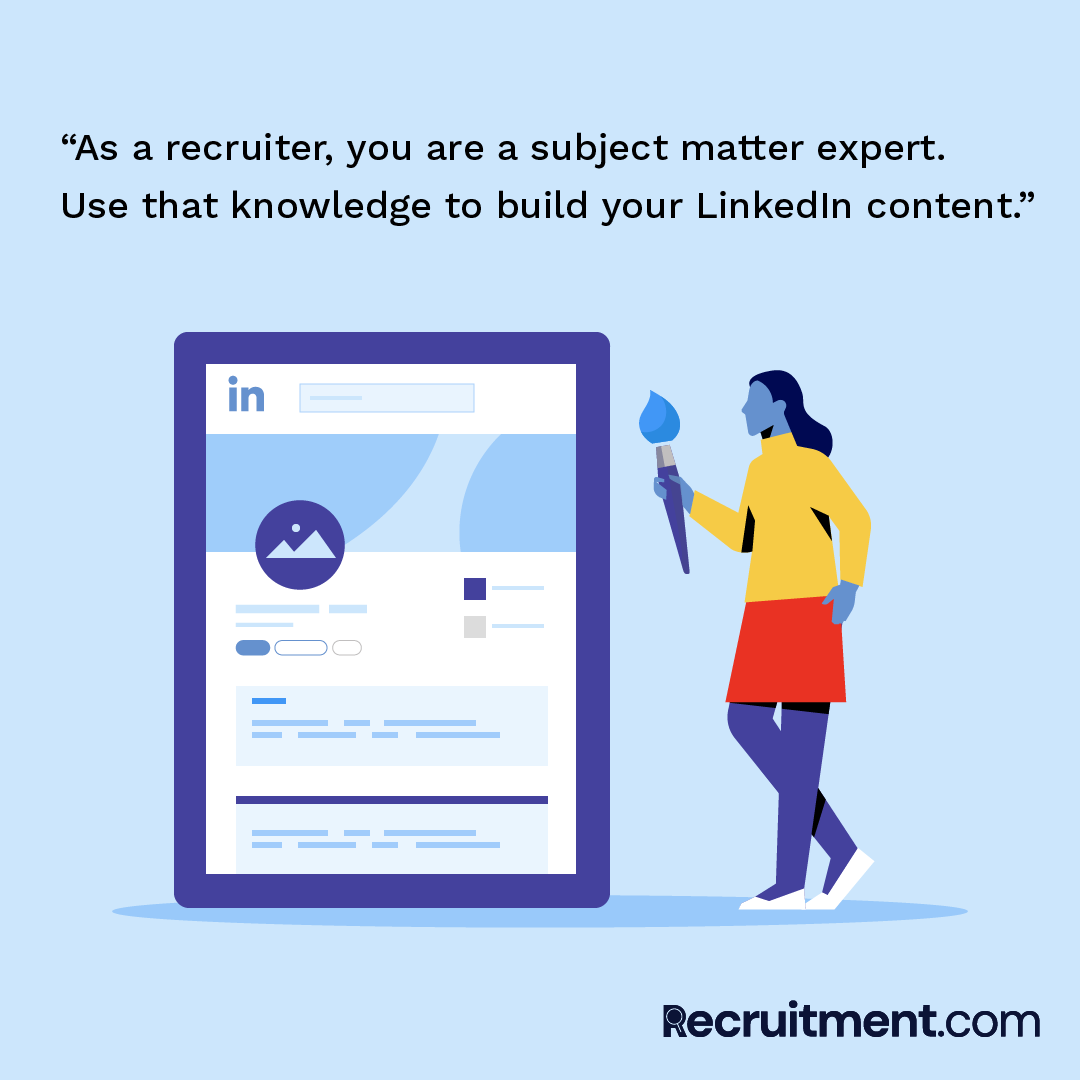
As a recruiter, you are a subject matter expert. Use that knowledge to build your LinkedIn content. Speak to what you know with passion and a novel angle, and people will pay attention. They’ll care about what you have to say, and you’ll attract people who can make a difference in your career, whether it’s a potential employer, a company that wants to draw on your job placement expertise, or an ideal candidate for a position you need to fill. When you post unforgettable content people will think of you first.
It’s funny—when I talk to Gen Zers, many don’t see the benefit of LinkedIn because they’re looking at it as a social platform. But they need to start looking at it as a networking platform. What’s the difference? You’re not here to socialize, you’re here to network. What would you do at a networking meeting? You would shake hands with people, get to know them, exchange information, understand their business—that’s how you have to look at LinkedIn too. It’s an ongoing networking opportunity.
Using LinkedIn this way has opened so many doors for me. I’ve gotten more opportunities on LinkedIn in the last six months than I have through other channels in the last five years. All of that was just because of posting and sharing industry knowledge. When you find your own voice, it can do the same for you. Get out there, connect with people! After all, that’s what LinkedIn is for.

Jordan Morten is an experienced recruiter and talent acquisition specialist who has held positions at the advertising tech startup MNTN and the global recruitment firm Aerotek. After more than 10 years in the industry, she launched her own recruiting services and career coaching firm, HireHearts Recruitment.
